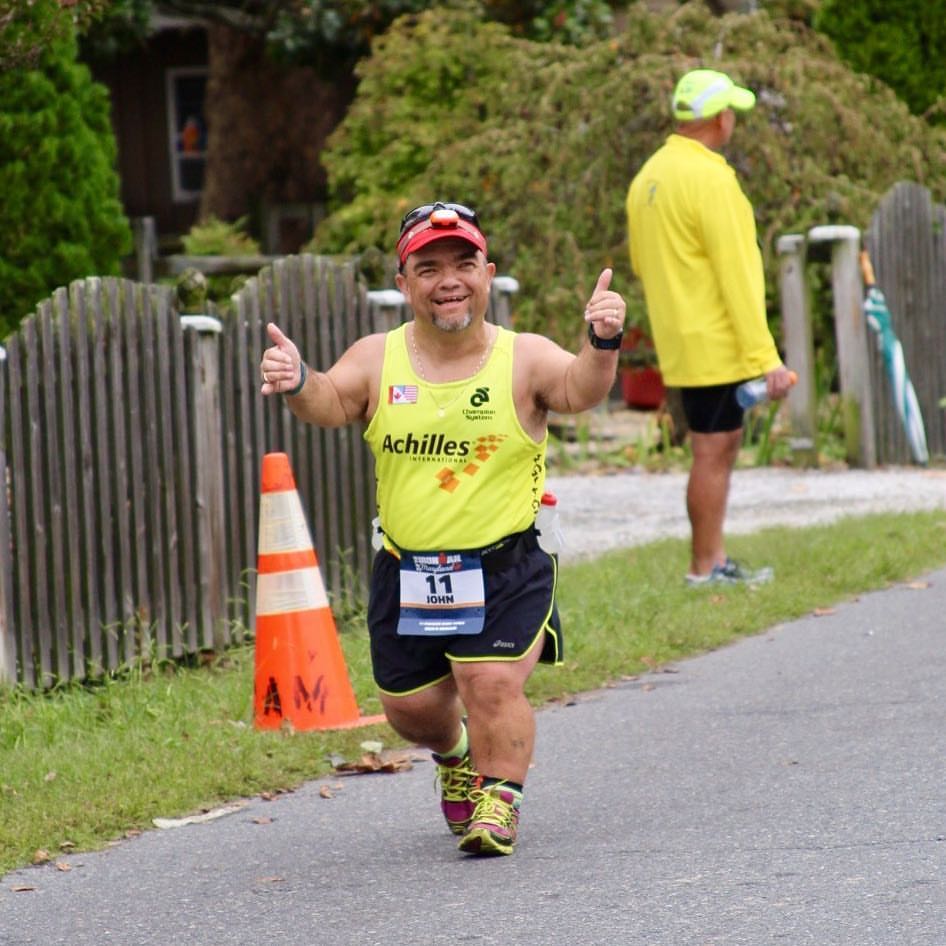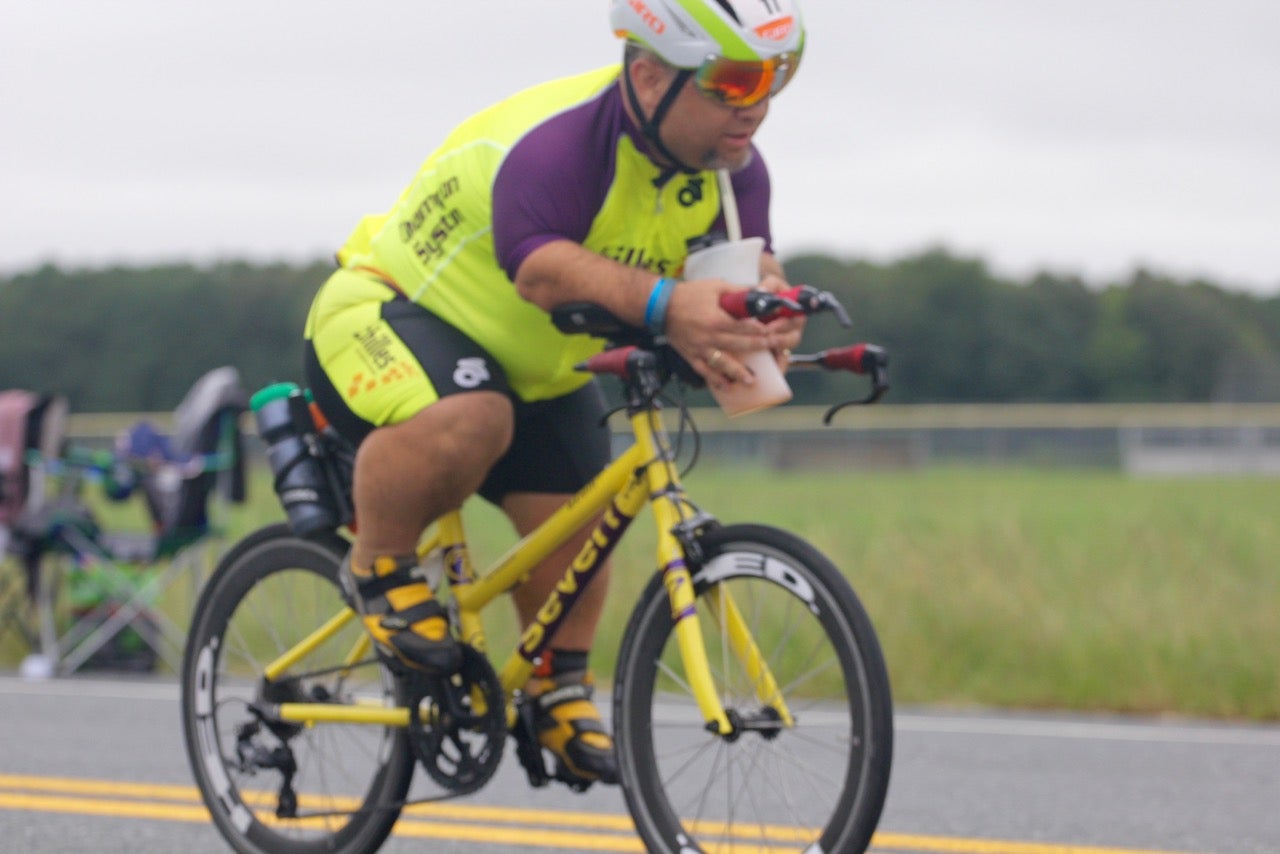
John Young Running, Photo Credit: Mindy Randall
Written by John Young (BMath ’90)
While I was a student at UWaterloo, I never considered myself very athletic. Especially compared to my friends who played on the men's varsity hockey and the swim team. However, I did swim a lot on my own time, and played some intramural sports, including hockey, softball and broomball. During the summer of 1986, I travelled to Dearborn, MI to compete in the U.S. Dwarf games where I competed in both track and swimming.
In 1990, I graduated from the Math Teaching Option and immediately started teaching full-time outside of Peterborough, ON at Norwood District High School. I was there for nine years and then needed a change, so my wife and I decided to try life overseas. We moved to Hong Kong where I taught for four years at an international school. Our son, Owen, was born while we lived there and so we decided to move back to North America. With my wife being a U.S. citizen, I was able to get a green card and so we decided to move to Massachusetts, where I took a job at a charter school. I was only there for one year when a position opened at Pingree School, a small prep school north of Boston. I have been teaching there since 2004, where I am also the coach of the varsity swim team.
I was not very active at this time and as a result in 2006, my wife encouraged me to go to the doctor, worried a bit about my lack of sleep. I was diagnosed with severe sleep-apnea, and when I stepped on the scale in the doctor's office, I weighed 195 lbs. That was a HUGE warning sign, with me being only 4'4" tall. I was prescribed a CPAP machine and almost immediately started getting some regular sleep. I soon had more energy and started back to swimming. Besides being a swimmer though, I had never been involved in any form of cycling or running.
One day, the school where I teach thought it would be nice to have a "bike to work" day. We live about 15km from where I work, and so I decided to borrow my wife's bike and rode to school. I loved it! A few months later, a friend sent me a video of Dick and Rick Hoyt completing the Hawaii Ironman. They are a father-son team where Rick, who has CP, is pushed or pulled by his father in triathlons and marathons. Watching that video inspired me to try my first sprint triathlon back in 2009, all at the age of forty-three.

Since then, I have completed over forty triathlons, including eight Half-Iron distance triathlons. I have also done eight marathons, including the NYC marathon twice and Boston three times. I will also be racing Boston again in 2017.
This past October I traveled to Cambridge, MD where I raced in Ironman Maryland, becoming the first person with dwarfism to race in an Ironman distance triathlon.
When I am in season, I train six days a week. I usually cycle three times for a total of approximately 140 miles, run three times for a total of 20 miles, and then swim once anywhere between 1.5-2 miles. I try to swim in the open water as much as possible. Luckily, where I live, there are both small ponds, lakes, and the Atlantic Ocean as well.
It's obvious that I have shorter limbs and so I need to take more steps to go the same distance as other athletes. My bike has smaller wheels and so I need to pedal more to go the same distance as other athletes. I don't say this to make excuses, it's just a fact. I don't worry about measuring myself against others and try to concentrate on myself and my race to do my best to improve my own performance.
For years, doctors have been telling people with short-stature that running was not a good form of exercise due to the stenosis we all seem to have as a consequence of my specific type of dwarfism (achondroplasia). The most rewarding aspect of racing in triathlon comes from letters and notes from people with short stature or from parents of children with dwarfism. Often, people with dwarfism are depicted in the media in a negative fashion, almost always they’re to be made fun of, and not taken seriously. The letters I've received often talk about the more positive image my racing represents to them; the idea that anything is possible.
I've also been able to race as a member of a team called Achilles International. All of our athletes have some form of physical or developmental challenge. For example, we have visually impaired athletes, athletes who have lost a limb, or athletes who have been affected by a TBI (traumatic brain injury). All of us do our best with the bodies we have and it's rewarding to work with other athletes dealing with a challenge that is different from my own. Many times, we find out our challenges are actually more similar than they are different.
Learn more about Achilles International, watch my interview with CNN, or check out my blog, LP (Dwarf) Triathlete.